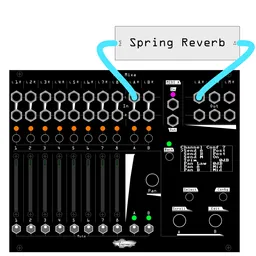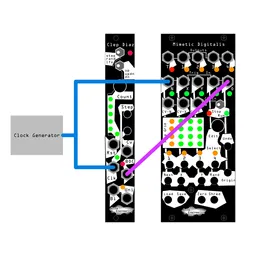Many sequencers, both traditional and contemporary, make it difficult to break away from equal-length steps. While this works for plenty of types of music, it also can be limiting for people who enjoy more off-the-grid composition. But how can we vary the step length of a sequencer that just has a clock input? It turns out, you can do it with just two NE modules! Let’s explore this concept.
Creating a voltage-controlled clock
Since most sequencers just advance when a clock tells them to, we need to look at the clock side of things instead of the sequencer itself. Note that some sequencers create their own clock based on what’s being input to them so this won't work in all cases, but it will work with NE sequencers (like Vox Digitalis, Bin Seq, and Zularic Repetitor) and any other sequencers that advance when they receive a trigger. Here’s how we’re going to create our funky clock. We need a voltage-controlled clock running a CV sequencer, which then feeds back into the clock and changes the clock time every step.
We can create our clock with a channel of Pons Asinorum, and modulate it with Mimetic Digitalis. Set PA to decay mode (the right switch position), and loop one of its channels. Change its rate so that it’s as fast as you’ll want a step to go (remember that increasing the CV at the input will slow it down). Patch PA’s output to Mimetic Digitalis’s N input. Then, take a CV output channel of MD and patch it to the CV input for the looping PA channel. When you change the CV level for a step on MD, that step then gets longer! Now we have a clock that outputs arbitrary length steps that we can change on the fly with MD. The T jack on MD outputs a nice trigger every time MD changes step, so we can use that as a clock for other modules in our system, like Bin Seq or Vox Digitalis. Or, we can just use the other 3 channels of MD for a patch. Once we break it down, it’s a pretty simple and easy-to-patch technique.
Talking about techniques is one thing, but let’s make some noises! Here, we’re using a slightly modified version of the patch described above. I’ve run the clock modulation channel through an offset from Lapsus Os, so we have even more control over the clock modulation. An unused channel of MD is modulating the pitch of Cursus Iteritas Percido, and we’re using the T out from MD to trigger it.
Unusual patches like this are a great way to add new dimensions of expression to a patch.
Learn more:
Remember, this is just one way to implement this technique. Some sequencers, like the Stillson Hammer MKII, have voltage-controlled clocks built-in so creating this sort of effect would be even simpler. Any LFO with CV over frequency will probably work for this, too. If you have one of our old Horologic Solum clock generators, it can be CV controlled and is a great candidate for this technique. You also don’t have to use a sequencer for the step-length modulation: a clocked modulation source like Clep Diaz or even a completely free-running LFO will give you more interesting and more randomized results, if that’s what you’re into. Try it out with the modules in your system, and if you make something cool, tag us on Instagram so everyone can see!






